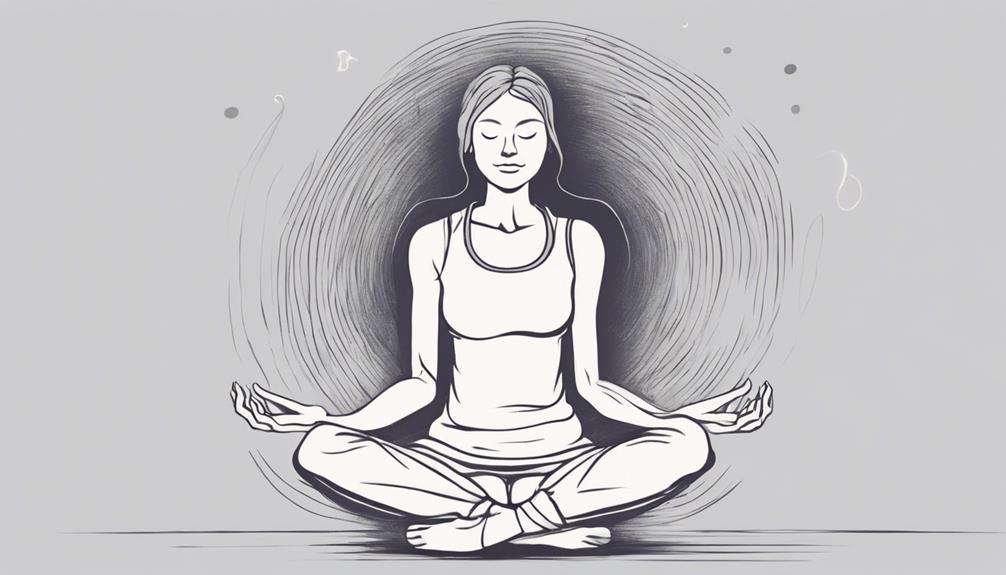Imagine chronic pain as a persistent rain cloud that follows you everywhere, casting a shadow over your daily life.
Now, picture a gentle breeze of mindfulness techniques that can gradually disperse this cloud, allowing rays of relief to peek through.
By exploring the three best ways to manage chronic pain with mindfulness, you can discover a path towards reclaiming control over your well-being and finding peace amidst the storm.
Key Takeaways
- Mindful breathing reduces stress and pain perception, aiding chronic pain management.
- Body scan meditation practice enhances awareness and relaxation to alleviate chronic pain.
- Mindful movement exercises improve physical function and reduce pain intensity.
- Mindful eating habits promote healthier choices and prevent overeating, supporting chronic pain management.
Mindful Breathing Techniques
If you're seeking effective ways to manage chronic pain, incorporating mindful breathing techniques into your daily routine can be a powerful tool for enhancing your well-being.
Mindful breathing involves focusing on your inhalation and exhalation patterns, which can increase your awareness of the present moment.
For chronic pain patients, this practice is particularly beneficial as research shows that mindful breathing can reduce stress, anxiety, and the perception of pain.
Body Scan Meditation Practice
Embark on a journey of self-awareness and relaxation by engaging in the practice of body scan meditation, a method proven to alleviate pain and enhance overall well-being in individuals with chronic pain conditions. Body scan meditation involves systematically focusing on different parts of the body, starting from the toes and moving up to the head, to cultivate awareness and relaxation.
Here are some key points about body scan meditation:
- Research indicates that body scan meditation can reduce pain intensity and improve overall well-being in individuals with chronic pain conditions.
- It helps develop a deeper connection with your body, enabling you to notice and release tension or discomfort.
- Encourages a non-judgmental awareness of sensations, emotions, and thoughts related to pain, fostering acceptance and self-compassion.
- Regular practice can increase mindfulness and resilience, leading to better pain management and an improved quality of life.
- By incorporating body scan meditation into your routine, you can enhance your ability to manage chronic pain with a more mindful and compassionate approach.
Mindful Movement Exercises

Transitioning from body scan meditation, engaging in mindful movement exercises like yoga or tai chi can significantly improve your flexibility, strength, and balance, ultimately reducing chronic pain. These exercises promote body awareness, allowing you to identify and release tension contributing to your pain experience. By fostering the mind-body connection, mindful movement enhances pain management and overall well-being.
Research indicates that regular practice of mindful movement decreases pain intensity and enhances physical function, making daily activities more manageable. Moreover, these exercises provide a gentle approach to staying active, promoting relaxation and stress reduction for individuals dealing with chronic pain.
Incorporating mindful movement into your routine not only offers physical benefits but also cultivates a sense of inner peace and resilience in coping with persistent pain. Embrace these exercises as a holistic strategy for managing chronic pain, nurturing both your body and mind towards better health and vitality.
Frequently Asked Questions
How to Do Mindfulness for Chronic Pain?
To do mindfulness for chronic pain, start with guided meditation and breathing exercises. Increase body awareness with body scans. Focus on the present moment to manage pain better. Practice self-care and stress reduction for holistic healing.
What Are the 5 Coping Skills Every Chronic Pain Patient Needs?
In managing chronic pain, you must focus on pain management, stress reduction, mind-body connection, coping strategies, and self-care. Embrace relaxation techniques, maintain a positive mindset, accept the pain, seek emotional support, and take a holistic approach.
How Do You Mentally Deal With Chronic Pain?
To mentally deal with chronic pain, focus on meditation, deep breathing, positive affirmations, relaxation techniques, cognitive therapy, visualization, mind-body connection, pain acceptance, grounding, and self-compassion. These practices help reduce pain perception and enhance overall well-being.
How Do You Retrain Your Brain From Chronic Pain?
To retrain your brain from chronic pain, engage in mindfulness practice. By focusing on the present moment, you can reshape pain perception and develop new neural pathways. This process enhances pain management, emotional regulation, and cognitive restructuring.
Conclusion
In conclusion, managing chronic pain with mindfulness is a powerful tool for improving quality of life.
Did you know that a study conducted by the National Institutes of Health found that mindfulness meditation can reduce pain intensity by 40% and pain unpleasantness by 57%?
By incorporating mindful breathing, body scan meditation, and mindful movement into your daily routine, you can experience relief from chronic pain and cultivate a positive mindset.
Start your mindfulness journey today for a holistic approach to pain management.






